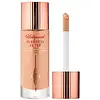Rituel de Fille Creature Of Light Full-Face Serum Illuminator Versus Charlotte Tilbury Hollywood Flawless Filter
What's inside
What's inside
 Key Ingredients
Key Ingredients

 Benefits
Benefits

 Concerns
Concerns

 Ingredients Side-by-side
Ingredients Side-by-side

Water
Skin ConditioningMica
Cosmetic ColorantTerminalia Ferdinandiana Seed Oil
AntioxidantTitanium Dioxide
Cosmetic ColorantC13-15 Alkane
SolventGlycerin
HumectantPropanediol
Solvent1,2-Hexanediol
Skin ConditioningEthylhexyl Olivate
Skin ConditioningTerminalia Ferdinandiana Fruit Extract
AntioxidantSodium Acrylates Copolymer
Polyglyceryl-4 Olivate
EmollientCitrus Aurantium Amara Flower Oil
MaskingTocopherol
AntioxidantGlycine Soja Oil
EmollientCI 77491
Cosmetic ColorantCaprylhydroxamic Acid
CI 75470
Cosmetic ColorantCaesalpinia Spinosa Fruit Extract
Skin ProtectingTin Oxide
AbrasiveTremella Fuciformis Extract
HumectantGluconolactone
Skin ConditioningKappaphycus Alvarezii Extract
Skin ConditioningSodium Benzoate
MaskingCalcium Gluconate
HumectantWater, Mica, Terminalia Ferdinandiana Seed Oil, Titanium Dioxide, C13-15 Alkane, Glycerin, Propanediol, 1,2-Hexanediol, Ethylhexyl Olivate, Terminalia Ferdinandiana Fruit Extract, Sodium Acrylates Copolymer, Polyglyceryl-4 Olivate, Citrus Aurantium Amara Flower Oil, Tocopherol, Glycine Soja Oil, CI 77491, Caprylhydroxamic Acid, CI 75470, Caesalpinia Spinosa Fruit Extract, Tin Oxide, Tremella Fuciformis Extract, Gluconolactone, Kappaphycus Alvarezii Extract, Sodium Benzoate, Calcium Gluconate
Water
Skin ConditioningHydrogenated Didecene
Skin ConditioningMica
Cosmetic ColorantGlycerin
HumectantPropanediol
SolventSqualane
EmollientCetyl PEG/PPG-10/1 Dimethicone
EmulsifyingIsoamyl Laurate
EmollientHydrogenated Styrene/Isoprene Copolymer
Sodium Chloride
MaskingCaprylic/Capric Triglyceride
MaskingHydroxyacetophenone
AntioxidantPolyglyceryl-4 Isostearate
Emulsifying1,2-Hexanediol
Skin ConditioningCaprylyl Glycol
EmollientTrisodium Ethylenediamine Disuccinate
Hoya Lacunosa Flower Extract
Skin ConditioningPentaerythrityl Tetra-Di-T-Butyl Hydroxyhydrocinnamate
AntioxidantCI 77891
Cosmetic ColorantIron Oxides
CI 77163
Cosmetic ColorantWater, Hydrogenated Didecene, Mica, Glycerin, Propanediol, Squalane, Cetyl PEG/PPG-10/1 Dimethicone, Isoamyl Laurate, Hydrogenated Styrene/Isoprene Copolymer, Sodium Chloride, Caprylic/Capric Triglyceride, Hydroxyacetophenone, Polyglyceryl-4 Isostearate, 1,2-Hexanediol, Caprylyl Glycol, Trisodium Ethylenediamine Disuccinate, Hoya Lacunosa Flower Extract, Pentaerythrityl Tetra-Di-T-Butyl Hydroxyhydrocinnamate, CI 77891, Iron Oxides, CI 77163
 Reviews
Reviews

Ingredients Explained
These ingredients are found in both products.
Ingredients higher up in an ingredient list are typically present in a larger amount.
1,2-Hexanediol is a synthetic liquid and another multi-functional powerhouse.
It is a:
- Humectant, drawing moisture into the skin
- Emollient, helping to soften skin
- Solvent, dispersing and stabilizing formulas
- Preservative booster, enhancing the antimicrobial activity of other preservatives
Glycerin is already naturally found in your skin. It helps moisturize and protect your skin.
A study from 2016 found glycerin to be more effective as a humectant than AHAs and hyaluronic acid.
As a humectant, it helps the skin stay hydrated by pulling moisture to your skin. The low molecular weight of glycerin allows it to pull moisture into the deeper layers of your skin.
Hydrated skin improves your skin barrier; Your skin barrier helps protect against irritants and bacteria.
Glycerin has also been found to have antimicrobial and antiviral properties. Due to these properties, glycerin is often used in wound and burn treatments.
In cosmetics, glycerin is usually derived from plants such as soybean or palm. However, it can also be sourced from animals, such as tallow or animal fat.
This ingredient is organic, colorless, odorless, and non-toxic.
Glycerin is the name for this ingredient in American English. British English uses Glycerol/Glycerine.
Learn more about GlycerinMica is a naturally occurring mineral used to add shimmer and color in cosmetics. It can also help improve the texture of a product or give it an opaque, white/silver color.
Serecite is the name for very fine but ragged grains of mica.
This ingredient is often coated with metal oxides like titanium dioxide. Trace amounts of heavy metals may be found in mica, but these metals are not harmful in our personal products.
Mica has been used since prehistoric times throughout the world. Ancient Egyptian, Indian, Greek, Roman, Aztec, and Chinese civilizations have used mica.
Learn more about MicaPropanediol is an all-star ingredient. It softens, hydrates, and smooths the skin.
It’s often used to:
Propanediol is not likely to cause sensitivity and considered safe to use. It is derived from corn or petroleum with a clear color and no scent.
Learn more about PropanediolWater. It's the most common cosmetic ingredient of all. You'll usually see it at the top of ingredient lists, meaning that it makes up the largest part of the product.
So why is it so popular? Water most often acts as a solvent - this means that it helps dissolve other ingredients into the formulation.
You'll also recognize water as that liquid we all need to stay alive. If you see this, drink a glass of water. Stay hydrated!
Learn more about Water